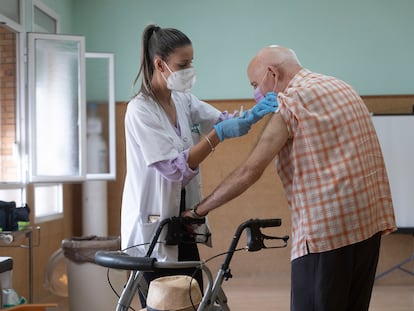The ongoing search for effective pain therapies
Treating chronic ailments requires a combined psychological, social and biological approach

Until very recently, pain was just a symptom, a warning of an impending illness or injury. Our hand was too close to the fire, or we hoisted a grandchild the wrong way. Pain was a signal to stop whatever we were doing, so the body could react and recover. But in 2020, the International Association for the Study of Pain (IASP) announced a revised definition of pain to better convey its subjective nuances: “An unpleasant sensory and emotional experience associated with, or resembling that associated with, actual or potential tissue damage.” The revised definition emphasizes that “a person’s report of an experience as pain should be respected,” because often the pain cannot be traced to a physical cause. In other words, don’t assume that people suffering from undiagnosed pain are making it up.
In many cases, pain itself is now considered to be a disease that can no longer be mitigated by treating a specific cause. It is a personal experience that involves biological, psychological and social factors. Pain is a subjective experience, but that doesn’t make it any less real. A 2014 report from Spain’s Ministry of Public Health estimated that one in six people suffer from chronic pain, yet health care professionals and scientists all say that not enough resources have been dedicated to understanding and treating such a widespread problem.
Western society usually turns to medications at the first sign of pain, but the initial treatment for many types of persistent pain may not be pharmacological. A 2018 article published in The Lancet recommended a “biopsychosocial” framework for managing chronic back pain. This framework includes education that supports self-management and resumption of normal activities and exercise, and psychological programs for those with persistent symptoms.
Beatriz Rodríguez Vega, who heads the psychiatry, clinical psychology and mental health department at La Paz University Hospital in Madrid, said: “In 2016, the US Centers for Disease Control and Prevention (CDC) recommended mindfulness-based approaches as an alternative to pain management using pharmacological and opioid treatments.”
Compassion-based therapies
“Despite scientific evidence and everyday clinical practice results,” said Rodríguez, “third-generation therapies based on mindfulness and compassion” are not widely used. “The training needed to master these therapies is complex and time-consuming. Also, the standardized protocols used in research require training as well. These programs are psychoeducational and could be applied during primary care as an initial intervention. But these practices are not well known, and there is a lack of training and time to implement them.”
Ángela Palao, who leads a team of chronic pain management researchers at La Paz University Hospital, published the results of a clinical trial in the European Journal of Pain that examined the effects of a “Mindful Self-Compassion” (MSC) program on relevant clinical outcomes in patients with chronic pain. Patients were randomly assigned to one of two intervention arms: MSC or a cognitive-behavioral therapy with the most evidence for treating the problem. After two months of 150-minute weekly sessions, the patients in the MSC program demonstrated better results in pain acceptance and anxiety levels than those who received cognitive behavioral therapy.
Given the subjective nature of pain, managing patient expectations is an essential part of any treatment. Alfonso Vidal, who heads the pain management department at La Luz Hospital in the Madrid city of Torrejón de Ardóz, says he always informs patients that “almost everyone experiences some pain relief, but almost no one is cured. It can be controlled, like hypertension, but it’s not going to go away.” This is true of all pain treatments – pharmacological, psychological and hybrid approaches. Carlos Goicoechea, a pharmacology professor at Rey Juan Carlos University in Madrid, says this is why some unscientific treatments may work temporarily.
Placebo pharmacology
“In a clinical trial, the placebo effect can have an analgesic effect of up to 20%, while a drug can have 40%,” said Goicoechea. But like all chronic pain treatments, the therapeutic effect eventually wears off. “Some unscrupulous people propose fantastic but short-lived remedies. These patients later lose hope of finding any solution to their pain,” he said. “Managing the emotions of chronic pain sufferers – typically a 65-year-old woman who has been in pain for eight years – is very difficult.” Goicoechea therefore recommends a pragmatic approach to the use of pain medication. “If a pharmacological approach is working, then it has to be maintained indefinitely. Does that mean taking pills for the rest of your life? If they help and don’t have harmful side effects, then there is no reason to discontinue the medication since pain can be considered a chronic disease.”
There are also physical interventions that can produce good results, although they can be expensive. Vidal mentions treatments like radiofrequency stimulation, which adjusts the way in which the nerve tissue functions, reducing pain along the pain-sensing pathway. There are also spinal cord stimulators, which are devices similar to a pacemaker that transmit electrical signals to the spinal cord to alleviate pain. However, many health systems and health insurance plans do not cover the cost. “Yet a person with a back problem is sent to a neurosurgeon who performs an invasive procedure that can cost €20,000 [$20,600], and this is fully covered,” said Goicoechea.
Researchers seeking better pain treatments are trying to understand the unchecked processes that result in chronic pain and cause the brain to no longer perceive it as a warning sign. Elvira de la Peña, a researcher with the Alicante Neuroscience Institute (southeastern Spain), explains that pain must be examined at various points of the body. She says there are peripheral points where the pain originates, like “when you prick a finger or undergo surgery.” Then there’s the central nervous system – the medulla and cerebral cortex – where the perception of pain occurs. “The most efficient therapies are those that act on the cerebral cortex, such as drugs that inhibit pain response. But they also have more side effects,” said De la Peña. “The medulla is difficult to access, and anesthesia can be used to treat pain at peripheral points. But we still don’t know why people can feel pain when its cause has been eliminated. Is this failure happening at peripheral points of the body or in the brain?”
New targets for pain management
At the Alicante Neuroscience Institute, Elvira de la Peña and Félix Viana are testing a drug developed by the Esteve pharmaceutical company that aims to prevent neuropathic pain resulting from colon cancer chemotherapy. Neuropathic pain is caused by a tactile and thermal hypersensitivity due to changes in a type of receptor known as a TRPA1 ion channel, which is a sensor for pain, cold and itch that gives rise to protective responses. Their experiments with mice indicate that a drug that blocks the sigma 1 protein can modulate the functioning of TRPA1 and normalize responses to the painful stimulus. Because it acts at the peripheral level, side effects are not a concern. Ion channels that sense heat, cold and pressure on the skin have become a new focus of pain research and treatment.
Optopharmacology, which refers to activation or deactivation of drugs in response to an external light source, is also being studied for its potential to release drugs with light stimuli at precise pain points. Immunotherapies, which have already shown their efficacy in cancer and rheumatic diseases, could be used to modulate the manifestation of pain. “We have good expectations for transcranial magnetic stimulation, which consists of focusing a magnetic field on certain brain structures,” said Vidal.
And in a field that seems like science fiction, “Gene editing is being applied in mice to block sodium channels [that communicate pain to the brain],” said Goicoechea. Modified sodium channels have been found in humans, such as the Pakistani teenager who didn’t feel pain due to a mutation in the SCN9A gene. A 2006 study of the young man’s condition was published in Nature. He worked as a fakir performing feats of endurance for money, and died at the age of 13 after jumping off a roof. He was an extreme example of the complex equilibrium between pain that we need to feel and pain that can be mitigated. Experts generally recommend getting medical attention for pain as soon as possible, because it is more easily alleviated when treated early.
Tu suscripción se está usando en otro dispositivo
¿Quieres añadir otro usuario a tu suscripción?
Si continúas leyendo en este dispositivo, no se podrá leer en el otro.
FlechaTu suscripción se está usando en otro dispositivo y solo puedes acceder a EL PAÍS desde un dispositivo a la vez.
Si quieres compartir tu cuenta, cambia tu suscripción a la modalidad Premium, así podrás añadir otro usuario. Cada uno accederá con su propia cuenta de email, lo que os permitirá personalizar vuestra experiencia en EL PAÍS.
¿Tienes una suscripción de empresa? Accede aquí para contratar más cuentas.
En el caso de no saber quién está usando tu cuenta, te recomendamos cambiar tu contraseña aquí.
Si decides continuar compartiendo tu cuenta, este mensaje se mostrará en tu dispositivo y en el de la otra persona que está usando tu cuenta de forma indefinida, afectando a tu experiencia de lectura. Puedes consultar aquí los términos y condiciones de la suscripción digital.











































